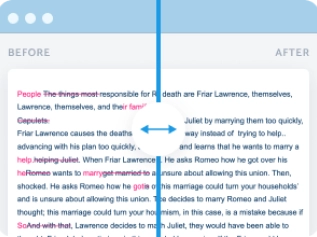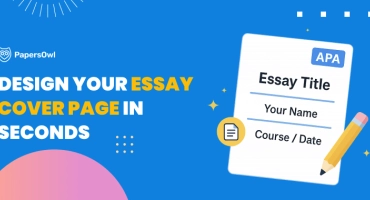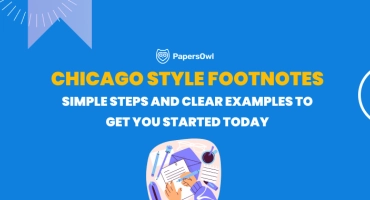The Chicago Manual of Style Format
Table of contents
- 1 History of Chicago Style in Academic Writing
- 2 What Are Two Primary Systems of the Chicago Manual of Style?
- 3 Notes-Bibliography vs Author-Date
- 4 What Changed in the Chicago Manual of Style, 18th Edition (2024–2025)
- 5 Citation Style Guide: General Formatting Rules
- 6 Citing Different Types of Sources
- 7 Student Paper Format
- 8 Extended Citation Style: Formatting Tables and Figures
- 9 Common Mistakes in Chicago Style
- 10 Using the Chicago Manual of Style in Academic Achievement
There are plenty of citation styles in an academic environment, but today, we will concentrate on the Chicago Style format.
It is a widely used citation and formatting style, also known as the Chicago Manual of Style (CMS). This citation style was first published in 1906 to help people to make their texts more readable and structured. University students primarily used the Chicago writing style, but the system was later used in other areas as well.
The latest edition, the 18th, was released in September 2024. It introduces key updates such as guidance on citing AI-generated content, new rules for alt-text descriptions of images, revised author-listing practices, and flexible options for shortened citations. These changes make the style more adaptable to modern digital and academic needs.
At the same time, Chicago style remains especially common in the humanities, history, and social sciences. If you’re new to it, tips for writing a Chicago-style paper can help you navigate its specific rules and make your work more professional and accurate.
In this article, we will provide you with an effective Chicago manual of style guide. We’ll also examine this system’s key features and applications in different science sections and discuss the main Chicago style rules.
History of Chicago Style in Academic Writing
The Chicago Manual of Style was developed by the University of Chicago Press. The material provides clear advice on how to format research articles, cite sources, and compile bibliography entries (Chicago Manual of Style 18th edition).
One of the features of the Chicago manuscript style is its universal flexibility. Generally, recommendations developed by experts can be used in absolutely different fields of science.
An example of how to cite (Chicago style) a source in a research paper:
- Dan Brown, The DaVinci Code (New York: Scholastic, 2004), 17-19.
This structuring (ibid Chicago style) has created an unspoken system of standards over time. Thus, students, teachers, and scholars worldwide can easily share their printed work thanks to the same formatting.
UPD: In Chicago style, the use of ibid. is now optional. The 18th edition recommends shortened citations instead, which may include the author’s last name only, the title only, or both the author and a shortened form of the title. For example: Smith, History of Art, 57.
At the same time, thanks to the use of a unified Chicago citation system, the papers have a clear and understandable structure.
As the popularity of this approach grew, so did the changes in computer software. For example, the creators of Microsoft Office automated several guidelines, making it possible to use Chicago style citation with simple keyboard shortcuts in MS word.
Are Chicago Manual and Turabian the Same?
Both citation styles adhere to the same principles of academic writing and citation. In fact, Chicago and Turabian style are similar, but they are not the same. Turabian originated as a variation of the Chicago style. It was named after Kate Turabian, who developed a simplified version of the Chicago style.
What Are Two Primary Systems of the Chicago Manual of Style?
The Chicago manual of style (CMOS) uses two systems for citing sources and formatting academic papers.
- “Author-date” system is particularly used in the natural and social sciences. According to Chicago style citations, one citation consists of the author’s surname and the year of publication. Example: Walkley, 2022.
The reference list is submitted at the end of the document. On the Chicago reference page sources are listed alphabetically by author’s surname. Each entry in the reference list includes full publication details such as the author’s name, title of the work, and publication information.
- The Notes-Bibliography system (Chicago bibliography) is mainly used in the humanities (literature, history, philosophy, art). Using this system, authors cite sources using full footnotes or endnotes, which appear in the text as superscript number or numbers.
The first citation of each particular source includes full publication details, and subsequent parenthetical citations may be abbreviated.
According to the Chicago style bibliography entry, source details are filed, including the author’s name, the work’s title, publication information, and other important words or information. You should also understand what a bibliography in APA is.
By applying the Chicago style sources approach, multiple authors of research papers and other academic works create quality work without additional effort. Thanks to standardization, the material becomes easy to read and use. In addition, universities often give additional points for competent design.
Notes-Bibliography vs Author-Date
The Chicago Manual of Style allows writers to choose between Notes-Bibliography (NB) and Author-Date systems.
Below is a quick reference table with examples for four common source types. Adapted from the Chicago Citation Quick Guide.
| Source type | Notes-Bibliography (Full Note) | Notes-Bibliography (Short Note) | Author-Date (In-text) | Author-Date (Reference list) |
|---|---|---|---|---|
| Book | 1. Michael Smith, Modern History Studies (Chicago: University of Chicago Press, 2022), 45. | Smith, Modern History Studies, 45. | (Smith 2022, 45) | Smith, Michael. Modern History Studies. Chicago: University of Chicago Press, 2022. |
| Journal Article | 2. Anna Johnson, “Cultural Shifts in the 21st Century,” Journal of Modern Culture 15, no. 2 (2021): 134. | Johnson, “Cultural Shifts,” 134. | (Johnson 2021, 134) | Johnson, Anna. 2021. “Cultural Shifts in the 21st Century.” Journal of Modern Culture 15 (2): 120–40. |
| Website | 3. Robert Lee, “History Education in the Digital Age,” University of Chicago, last modified May 5, 2023, https://uchicago.edu/history. | Lee, “History Education.” | (Lee 2023) | Lee, Robert. 2023. “History Education in the Digital Age.” University of Chicago. Last modified May 5, 2023. https://uchicago.edu/history. |
| Video/Podcast | 4. The Future of Learning, directed by Sarah Brown (New York: Academic Media, 2022), video. | Future of Learning. | (Brown 2022) | Brown, Sarah, dir. 2022. The Future of Learning. New York: Academic Media. Video. |
What Changed in the Chicago Manual of Style, 18th Edition (2024–2025)
- AI-generated content — The new edition clarifies how to cite AI tools like ChatGPT. For example, you may include an in-text note: “ChatGPT, response to author’s query, February 2025.”
- AI images — When using AI-created visuals, provide a credit line such as: “Image generated by MidJourney AI, February 2025.”
- Alt-text for accessibility — Authors are encouraged to add concise descriptions of images, e.g., “Line graph showing student enrollment growth from 2010 to 2020.”
- Author lists and et al. — Up to six authors should be listed in full; more than six → first three + et al.
- Shortened citations instead of ibid. — Replace ibid. with shortened forms: author-only, title-only, or both (e.g., Smith, History of Art, 45).
- Capitalization after colons — The 18th edition recommends capitalizing the first word after a colon if it begins a complete sentence.
- Emoji and punctuation — New guidance on how to handle punctuation around emojis, e.g., place periods before the emoji: “This was the best decision. 🙂”
- Wayback Machine citations — When citing archived web pages, include the original URL and the archive link, e.g., “https://web.archive.org/web/20240101/example.com”.
Citation Style Guide: General Formatting Rules
The most common question is: what is Chicago style in text citation? However, the Chicago style title is just as important as the formatting of the entire document.
Accordingly, the Chicago style guide applies to parenthetical citations, headings, font, and spacing. Below, we describe a few of the most important principles.
- Page Specifications. According to the Chicago format, page numbers should have margins (1 inch).
- Styling the document: Font and Space Bar. The Chicago Manual of Style doesn’t require a specific font or font size, so Times New Roman is usually used (size 12). The Chicago writing format also requires that all pages be numbered (top or bottom, usually in the upper right corner). The initial page can be numbered in an “invisible” font. Meanwhile, the main text should include double space, and each new paragraph should begin with a ½ inch indent. Each footnote and bibliography must be single spaced. You can also use a blank line in any part of your text if required.
- The Title Page should be an informative part of the entire document. The title page (Chicago style) or the first page of the paper contains the student’s first and last name, the title of the academic paper, the teacher’s first and last name, the title of the topic, and the year. This information for the cover page may vary depending on the educational institution’s rules.
- Headline style and subheadings are also governed by the Chicago citation guidelines. The heading is constructed according to the following principle: headline style capitalization is applied to the first and last words. The same applies to nouns, pronouns, verbs, adverbs, and adjectives. For subheadings, only the first word or proper nouns are capitalized.
- Formatting of names and numbers. In Chicago style formatting, author date style mentions, and source titles are used as they appear in the source.
- Quotation. In Chicago style, prose quotations of five or more lines (or around 100 words) should be formatted as block quotes. These are presented as a separate indented paragraph, without quotation marks, and are typically single-spaced. Any citation, such as a footnote or parenthetical reference, should follow the punctuation at the end of the block.
- Reference List. Start a reference list on the new page and list references alphabetically. The names of books, magazines, and newspapers are italicized. In Chicago style, dates are written in the month–day–year format, for example July 24, 2020. The day should not include an ordinal ending (e.g., ‘24th’). An alternative style accepted in non-U.S. contexts is 24 July 2020. If a numeric format is required, Chicago recommends the international standard YYYY-MM-DD (e.g., 2020-07-24). According to Chicago style, numbers from zero through one hundred are usually written out in words (e.g., twenty-five, ninety-nine, one hundred), as well as round numbers such as one thousand. Numerals are preferred for numbers above one hundred and for technical or statistical contexts.
To summarize, what is Chicago style representing is a set of clear and simple rules. All of them are recommendatory. Nevertheless, students, teachers, and scientists point out the obvious advantages of using a standardized system.

Citing Different Types of Sources
Citing different types of sources in the Chicago manual style, particularly in the Notes and Bibliography style (NB) system, requires attention to detail and consistency. Here are some important points to consider when following the Chicago formatting style.
Style Guide on How to Apply Full and Shortened Footnotes
Footnote ─ additional information is added at the bottom of the page. The footnote usually includes the author’s name, publication title, publication information, date of publication, and page number(s) if it is the first time the source is being used. It is a really important part of academic writing, especially in CMS.
If you’re unsure about the details, learning how to format Chicago footnotes correctly will help you avoid common mistakes and ensure proper citation throughout your work.
There are two concepts in Chicago style footnotes. When citing a source for the first time, complete information is usually given in the footnote. In this case, in addition to giving the authorship, you must provide additional information we mentioned before. However, the subsequent quotation can appear in the shortened footnotes (author, title, year).
How to Cite Common Resources in the Chicago Manual?
Chicago style writing eliminates the option of not citing multiple sources. Thus, every pro essay writer should indicate where they got this information and then format it according to accepted standards. Here are some footnote examples so it becomes more clear for you how to cite in CMS:
Books:
- Full Note: Author’s First Name Last Name, Book Title (Place of Publication: Publisher, Year), Page Numbers.
- Shortened Citation: Last Name, Shortened Title, Page Number.
- Extra: When a specific chapter (or other titled part of a book) is cited in the notes in the Chicago Manual of Style, the author’s name is followed by the chapter title (or other part), followed by a period, followed by the book title.
Journal Articles:
- Full Note: Author’s First Name, Last Name, “Title of Journal Article,” Title of Journal, Volume Number, Issue Number (Year): Page Range.
- Shortened Form: Last Name, “Shortened Title,” Page Numbers.
- Note: In other styles, the access date for digital documents must also be mentioned. However, it is not recommended in Chicago style unless the source’s publication date or last revision can be located.
Websites:
- Full Note: Author’s First Name Last Name (if available), “The Website Name,” Title of Website or Publisher, Publication Date or Revision Date, digital object identifier (URL).
- Short Note: Last Name (or the site’s name), “Shortened Title”.
Newspaper Articles:
- Full Note: Author’s First Name Last Name, “Title of Article,” Title of Newspaper, Volume and Issue Numbers (Month Day, Year) of an Article.
- Short Note: Last Name, “Shortened Title”.
Encyclopedia Entries:
- Full Note: Author’s First Name Last Name, “Title of Entry,” Title of Encyclopedia, Edition (Year), s.v. “Entry Title.”
- Short Note: Last Name, “Shortened Title,” s.v. “Entry Title”.
Interviews:
- Full Note: Interviewee’s First Name Last Name, Interviewer’s First Name Last Name, Date of Interview.
- Short Note: Last Name, “Shortened Title”.
If you are unsure about how to structure your interview or how to make it more compelling, learning how to write an engaging interview essay can help you present the conversation in a way that captivates your readers and highlights the most important points.
Films or Videos:
- Full Note: Title of Film or Video, Director’s First Name Last Name (Year; City: Publisher, Format).
- Short Note: Shortened Title.
Social Media Posts:
- Full Note: Author’s First Name Last Name, “Content of Post,” Social Media Platform, Date, URL.
- Short Note: Last Name, “Shortened Title.”
Lectures or Presentations:
- Full Note: Speaker’s First Name Last Name, “Title of Lecture,” Event, Location, Date.
- Short Note: Last Name, “Shortened Title.”
Artworks:
- Full Note: Artist’s First Name Last Name, Title of Artwork, Year, Medium, Location.
- Short Note: Last Name, “Shortened Title.”
Multiple authors (Chicago 18th edition):
- Full Note: Michael Smith, Anna Johnson, and Robert Lee, Modern History Studies (Chicago: University of Chicago Press, 2022), 45.
- Short Note: Smith, Johnson, and Lee, Modern History Studies, 45.
(If there are more than six authors: list the first three, followed by et al.)
How to Cite AI: Text and Images
The 18th edition provides guidance for citing AI-generated materials.
Text (e.g., ChatGPT):
Mention in the text if the AI is not recoverable: “This answer was generated using ChatGPT (February 2025).”
If necessary, include a note:
- NB Full Note: 1. ChatGPT, response to author’s query, February 15, 2025.
- Short Note: ChatGPT, response, Feb. 15, 2025.
- Author-Date: (ChatGPT, February 15, 2025).
Images (e.g., MidJourney, DALL·E):
Provide a credit line and note the generator: “Image generated by MidJourney AI, March 2025.”
- NB Example: 2. MidJourney AI, “Landscape with Mountains,” image generated March 2025.
- Author-Date Example: (MidJourney AI 2025).
Digital and Unconventional Sources (2025 Edition)
Modern research often requires citing sources beyond books and articles. CMOS 18 clarifies how to handle them:
Social media (X/Twitter, Instagram, TikTok):
- NB: 1. @studentlife, “Final exams week mood,” TikTok video, March 2, 2025, https://www.tiktok.com/@studentlife/video/123.
- Author-Date: (@studentlife 2025).
YouTube (with timestamp):
- NB: 2. Algebra Basics Explained, YouTube video, 12:15, posted by MathChannel, January 10, 2025, https://youtube.com/example.
- Author-Date: (MathChannel 2025, 12:15).
Podcast:
- NB: 3. The History Hour, hosted by Laura Green, March 1, 2025, Podcast audio.
- Author-Date: (Green 2025).
Datasets:
- NB: 4. U.S. Census Bureau, Population Data 2024, dataset, https://census.gov/data.
- Author-Date: (U.S. Census Bureau 2024).
Preprints / Ahead-of-print:
- NB: 5. John Doe, “New Approaches to Climate Modeling,” preprint, arXiv, January 2025.
- Author-Date: (Doe 2025).
Archived pages (Wayback Machine):
- NB: 6. Example.com, “Research Tools,” archived January 1, 2025, https://web.archive.org/web/20250101/example.com.
- Author-Date: (Example.com 2025).
That is what Chicago style works cited templates look like. Sometimes, you also might need to use atypical sources.
For example, you use an audio recording of a conversation with someone you know. In such a case, the full citation principle involves providing as much information about the same source as possible.
However, to cite it in a shorter version or mention it in the footnote at the bottom of the page is not really recommended in this case.
Student Paper Format
When formatting a student paper in Chicago style, follow these essentials:
👉 See the official sample paper for detailed formatting.
Extended Citation Style: Formatting Tables and Figures
In the Chicago style manual, you will also find information on how to work with tables and shapes. Such objects are also an important source of data transfer.
- Each table should have its name, specified by the principle of headings in Chicago style.
- Each column should have titles, any figure number should be also mentioned and any footnote citation should be placed below the table.
- If it is necessary to refer to a table, the name of the table and the page on which it is placed should also be mentioned.
Drawings and pictures (any images) are also subject to Chicago referencing. The author should indicate where this or that picture was taken.
In general, citation of textual materials extends to visual objects. In the Chicago Manual of Style, tables and figures should be placed as close as possible to the text where they are referenced, either on the same page or the following page.
Headings and Subheadings in CMOS 18
The 18th edition allows headings to appear in Title Case or Sentence case, but consistency is required across each level.
Example 1 — Title Case:
-
Major Words Are Capitalized in Headings
-
Subheadings Follow the Same Pattern
Example 2 — Sentence case:
-
Only the first word and proper nouns are capitalized
-
Subheadings follow this style consistently
Use one style per paper, not a mix of both.
Common Mistakes in Chicago Style
Even experienced writers make small but costly mistakes when using Chicago style.
Here are the most frequent pitfalls — and how to fix them:
-
Mixing NB and Author-Date
❌ Full note with Author-Date references.
✅ Choose one system and stick to it consistently. -
Incorrect URL/DOI formatting
❌ Truncated or missing “https://”.
✅ Always use full, working URLs or DOI links. -
Adding access dates everywhere
❌ Accessed July 12, 2024 (for every website).
✅ Include access dates only if no publication/updated date is available, or for unstable sources. -
Numbers 1–100 written as numerals
❌ “There were 25 students.”
✅ “There were twenty-five students.” -
Overuse of ibid. (outdated)
❌ Ibid., 40.
✅ Use shortened citations: Smith, Modern History Studies, 40. -
Block quotation errors
❌ Four-line quote in quotation marks.
✅ Five or more lines (≈100 words) should be a block quote, indented and without quotation marks.
Using the Chicago Manual of Style in Academic Achievement
Each academic paper benefits from adhering to Chicago style endnotes, ensuring parenthetical citation and scholarly credibility. Moreover, Chicago style annotation enhances understanding and research thoroughness, contributing to each paper’s quality. Sometimes, students perceive this approach as “too difficult.”
However, working with the Chicago Manual of style is worth trying at least once. And you will see from your example how much easier it becomes to work with large volumes of information.
Thanks to CMS, everything in your work, from the title page to the reference list, will look structured and organized. As a result, your academic papers will become really deep and valuable from a scientific point of view.
Remember: not only the cover page (Chicago style) has a matter. Following Chicago manual style page formatting guidelines ensures consistency and readability in each document, fostering your academic success.







